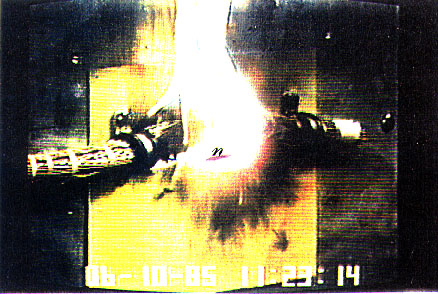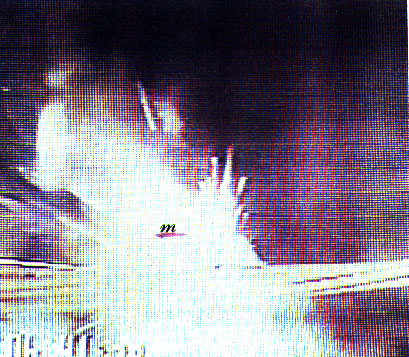Aircraft Wire Arc Tracking


The Burning of MIL-W-81381/11 wires which were ignited when circuit breakers were reset

This is the initial flashover. The beginning of an arc tracking fire.


The Burning of MIL-W-81381/11 wires which were ignited when circuit breakers were reset

This is the initial flashover. The beginning of an arc tracking fire.
A KAPTON ELECTRICAL FIRE EXAMPLE
A true Lab example concerning Kapton wire mixed with X-link Tefzel type wire i.e. what could have happened on Swissair 111. While assigned to the Boeing Electrical Arc Testing lab, I was asked to construct a wire bundle (w/b) for test, comprising several types of A/C wire to include, Kapton
(BMS 13-51 wire) and X-link Tefzel (BMS 13-48 Raychem's wire). I was to prepare the w/b for testing with our mechanical agitator (dry arc tester).
The test began by turning on the electrical power to the w/b and applying the mechanical agitator, drawing a piece of aluminum structure across the w/b at a constant speed. Within 5 minutes, we obtained FLASHOVER and the results were most horrifying. (note: As long as one wire in the w/b is still carrying electrical energy, the electrical fire will continue to travel like a dynamite fuse). In order to STOP the electrical fire, all energy has to cease i.e. destroyed wire and/or c/bs tripped.
Before ALL ELECTRICAL ENERGY CEASED, 28 inches of the w/b had been DESTROYED!
It acted like a dynamite fuse. You could see where the w/b was lying by the BLACK SOOT that was burned into the piece of Formica board.
Swissair 111 scenario: Now imagine what could have transpired onboard Flight 111. The IFES wiring of X-link Tefzel started to arc track and smoke. X-link Tefzel (Raychem's wire) has a smoke density of greater than 96% and is not as explosive as Kapton wiring. This smoke is what the cockpit crew first smelled and then it became visible smoke. They broadcasted a PAN message to alert ATC they had a problem. Soon, the arc tracking condition widened and spread to the greater supply of Kapton w/bs and all hell broke loose.
After the Boeing engineer witnessed the test example and the spectacular results, he informed us to keep the results under hat. Maybe you can now see, how dangerous Kapton wire can be if it is exposed to electrical arcing. Kapton wire should be banned from all types of airplanes, space vehicles and any other type of transportation that carries passengers.
IF YOU WANT TO FLY SAFER, READ!
Aging Aircraft and Types of A/C Wire Reduce ODDS of playing 'Russian Roulette!'
Before making your next flying trip, check with your airlines to see how old the jet you will be flying. Is it wired with TKT type wire? As commercial jets get older, the chances of making a safe trip are greatly reduced. The FAA, airlines, aircraft manufacturers, travel agencies and insurance carriers are banking on you making a SAFE TRIP. The odds are in your favor, BUT you could end up another SR 111 'Russian Roulette' victim.
Otherwise, the Air Industry would be taking steps to implement greater safety by installing the ONLY safe aircraft wire. TKT wire is ARC RESISTANCE and the only A/C wire type that can meet FAA FAR 25 regulations. TKT wire has a smoke density of less than 2%. Raychem's X-link Tefzel (BMS 13-48 wire type) has a smoke density of greater than 96%. If, Raychem's wire insulation is ignited by an electrical fire, smoke in the cockpit would make it almost impossible for the pilot to see the instruments in a very short time.
Now imagine you are flying to Switzerland, and you are midway across the Atlantic Ocean when an electrical fire ignites the X-link Tefzel or Kapton insulated A/C wire. You may have to ditch the A/C in the ocean. If that same plane had been wired with TKT wire, NO PROBLEM! You would live to see another day.
Passengers onboard Swissair 111 went down with their KAPTON wired A/C. Passengers on the recent Caledonian DC-10, who had to make an emergency landing in the Azores, are lucky. The Caledonian DC-10 with 356 passengers, started filling up with smoke in mid-Atlantic about midnight. The crew put out a mayday and shortly afterward, told NY Oceanic Control that they "may have to ditch". They are alive today but by only a very small margin. It was wired with KAPTON wire like SR 111. It was manufactured in 1980. SR 111 was manufactured in the '90s. If, they would have had TKT wiring,, SR 111 passengers would be alive today. The passengers on the DC-10 would not have had to worry about ditching in the ocean. Is it fair that the FAA doesn't mandate that ALL new A/C be wired with TKT type wire.
Everyone in the Air Industry has always looked at wiring as "out of sight, out of mind." To quote Tom McSweeny, Ass't Administrator of the FAA, "WIRE IS WIRE." The wire types of Kapton, X-link Tefzel, PVC, Stilan, and Poly-X have all been involved in air incidents and crashes. TKT being 'arc resistance' would not have to worry about an electrical arc tracking fire igniting the wire insulation material causing smoke/fire.
If you want to increase your odds of playing 'Russian roulette,' call your scheduled airline and ask "if your A/C is wired with TKT wiring." If it isn't and it is an older A/C, then find an airline that can provide you greater safety with a TKT wired jet. The only A/C that I know of with TKT type wire are 737 and 757s built in late 1992 and on, and very few of the last MD-11s produced before the Boeing-MD merger. MD was changing over to TKT wire just before the merger. Boeing doesn't use TKT wire on their 747, 767 and 'fly-by-wire' 777 models. Ask Boeing why. Since Alex Taylor, chief engineer of A/C wiring for Boeing, stated, "it is the only arc resistance wire type," why haven't they used TKT on ALL their models? Maybe GREED and POLITICS are involved?
Be sure to call your airlines and ask those questions so that you can enjoy your trip via air.
